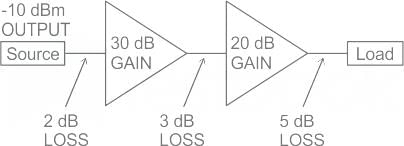Test: Differential Amplifiers - Electronics and Communication Engineering (ECE) MCQ
10 Questions MCQ Test GATE ECE (Electronics) Mock Test Series 2026 - Test: Differential Amplifiers
For an amplifier, which parameter is calculated with Vs = 0?
When voltage gain Av is greater than 1, the voltage gain in dB is ______.
A signal that is applied with equal strength to both inputs of a differential amplifier or an operational amplifier
The negative feedback _______ input impedance of an amplifier.
An amplifier has a gain of 20 without feedback. If 10% of the output voltage is fed back by means of a resistance negative feedback circuit, the overall gain would be:
In a common emitter amplifier the unbypassed emitter resistance provides:
Which of the following characteristics is NOT desirable for the DC amplifier?
In the figure shown below, what is the expected power level at the input to the receiver?

In an ideal CC amplifier circuit, output voltage is_______ its input voltage.
|
26 docs|263 tests
|





















